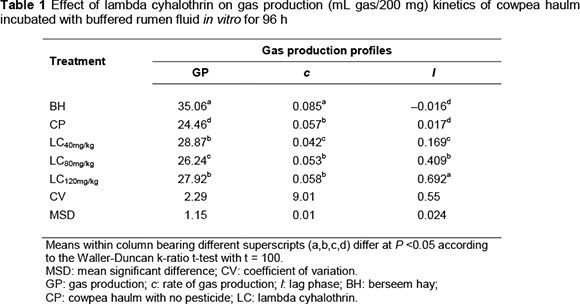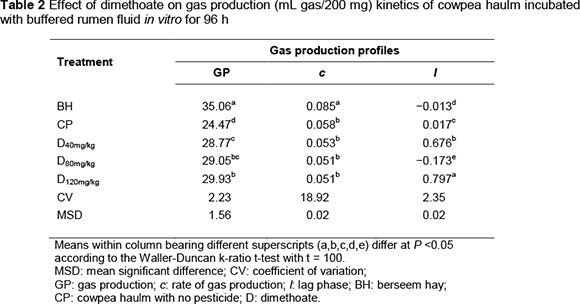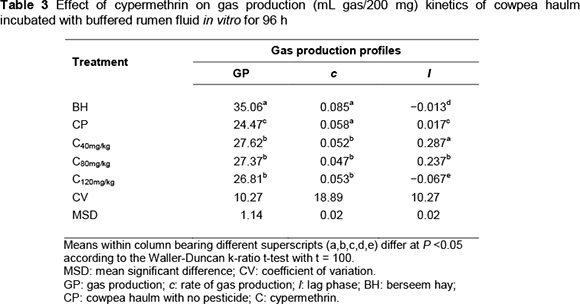Services on Demand
Article
Indicators
Related links
-
 Cited by Google
Cited by Google -
 Similars in Google
Similars in Google
Share
South African Journal of Animal Science
On-line version ISSN 2221-4062
Print version ISSN 0375-1589
S. Afr. j. anim. sci. vol.44 n.3 Pretoria Mar. 2014
SHORT COMMUNICATION
Effect of pesticides applied in cowpea production on rumen microbial fermentation of cowpea haulms as reflected in in vitro gas production
C. AntwiI, # ; E.L.K. OsafoI; D.S. FisherII; H.M. YacoutIII; A. DonkohI; A.A. HassanIII; S.M.M. SobhyIV; H.Adu-DapaahV; A.Z.M. SalemVI
IDepartment of Animal Science, KNUST-Kumasi, Ghana
IIUSDA-ARS, Watkinsville, GA 30677-2373, USA
IIIAnimal Production and Research Institute, Ministry of Agriculture, Gizza, Egypt
IVDepartment of Animal Production, Faculty of Agriculture (El-Shatby), Alexandria University, Egypt
VCouncil for Scientific and Industrial Research-Crop Research Institute, Kumasi
VIFacultad de Medicina Veterinaria Zootecnia. Universidad Autónoma del Estado de México, México
ABSTRACT
The present study assessed the effect of lambda cyhalothrin, cypermethrin and dimethoate residues in cowpea haulm on microbial fermentation using gas syringes as incubators. The lambda cyhalothrin, cypermethrin and dimethoate were applied at the vegetative, flowering and podding stages of the cowpea at the rate of 2.66 mg/L, 5.14 mg/L and 6.68 mg/L of water, respectively. Dimethoate was detected in the cowpea haulm at the highest concentration of 1.38 mg/kg. The haulm with no pesticide treatment was incubated with media containing rumen fluid, and pesticides were added at concentrations of 40 mg/kg, 80 mg/kg and 120 mg/kg. In vitro gas production was measured at 3 h, 6 h, 12 h, 24 h, 48 h, 72 h and 96 h to estimate the rate of gas evolution. Gas production in general was influenced by pesticide application. In general, gas evolution was reduced by increasing levels of lambda cyhalothrin up to 80 mg/kg. However, an increase in gas accumulation was observed with increasing levels of dimethoate, while the application of cypermethrin yielded no noticeable change in gas production. The study indicates that pesticide residues may function as toxins at concentrations greater than those encountered in the field or lethal dose (LD50) and may inhibit the growth of rumen microbes.
Keywords: Lambda cyhalothrin, cypermethrin, dimethoate, cowpea haulm, gas production.
Cowpea is a nutritionally important legume crop that is grown for its leaves and grains for human consumption (Nielsen et al., 1997), while the haulm is fed to livestock (Singh et al., 2003) or incorporated into farmyard manure or soil (Mortimore et al., 1997). Cowpea haulm plays a major role as a supplement for ruminants fed poor-quality basal diets. Savadogo et al. (2000) reported improved performance of sheep when cereal straws were supplemented with the haulm of cowpeas. Cowpea production, however, is considered too risky an investment by many farmers because numerous insect pests damage the crop, from seedling emergence right to storage (Jackai & Adalla, 1997). Therefore, for a complete protection of the cowpea crop, application of lambda cyhalothrin, dimethoate, and cypermethrin is recommended (Afun et al., 1991) and commonly practised in Ghana and other sub-Saharan African countries. Inherent problems of pesticide residue accumulation and degradation compounds in edible tissues (Laben, 1968) associated with pesticide use are well recognized. Studies of these pesticides have concentrated on their degradation rates in plants and excretion products in the urine and faeces of ruminants (Gutenmann et al., 1968). However, not much research has been conducted on the effect of pesticide-contaminated cowpea or forages on the microbial fermentation kinetics of ruminants.
Rumen microbial fermentation supplies approximately 50% - 70% of the energy requirements of ruminants (Annison & Lewis, 1959). Therefore the role of rumen microbes in ruminant nutrition cannot be overemphasized. Consequently, any factor that alters the rumen microbial ecology adversely might influence digestion in the rumen, resulting in reduced animal performance (Schwartz & Nagy, 1974).
The study sought to investigate the effects of the three pesticides at varied concentrations on in vitro gas production levels and some predicted rumen fermentation parameters.
Three pesticides, namely lambda cyhalothrin, cypermethrin and dimethoate, were employed to control insects at an application rates of 2.66 mg/L, 5.14 mg/L and 6.68 mg/L of water, respectively, as recommended by the manufacturers. Pesticides were applied at the inception of pest invasion. The cowpeas were sprayed with lambda cyhalothrin against pre-flowering insects, and cypermethrin and dimethoate against post-flowering insects.
The extraction of pesticide residue was done according to the procedures of Fillion et al. (1995). An aliquot of 10 mL was transferred to a clean 15 mL tube and evaporated to 0.5 mL under a nitrogen water bath at 35 °C. This was transferred into an ENVI-Carb SPE tube and eluted with 20 mg acetonitrile/toluene (3 : 1). The elute was transferred to a clean 15 mg tube and 50 µL internal standard added and brought to a volume of 2.5 mg with acetone, of which 0.5 mL was used for gas chromatography analysis of the pesticide residues. Splitless injection of 1 µL was carried out at 270 °C and splitless time 1.5 minutes. Column temperature was initially set at 80 °C and held for 2 min, then increased at a rate of 35 °C/min to 170 °C and held for 13.5 min. This was followed by 10 °C/min to 230 °C, held 7 min, and was finally increased at a rate of 10 °C/min to 300 °C for 3 min. The carrier gas flow rate was 2 mL/min. Pesticide residue was estimated as:

where [pesticide/sample] = concentration of pesticides and sample, respectively.
Stock solutions of the various pesticides ranging from 2.66 mg (lambda cyhalothrin) to 5.14 mg (cypermethrin) to 6.68 mg (dimethoate) were dissolved in 1 L distilled water. Known volumes of 40 mg/kg, 80 mg/kg and 120 mg/kg were dispensed into gas syringes containing 210 mg pesticide-free cowpea haulm. The volumes of pesticide residues in this experiment were varied above the levels (1.8 µL cypermethrin and 1.38 µL dimethoate with no detection of lambda cyhalothrin in the samples) detected in the haulm to ascertain the effect of the residues beyond the recommended levels. Rumen fluid for the in vitro fermentation studies was obtained from two rumen-fistulated Barki rams (45 ± 2 kg average live weight) which had ad libitum access to berseem hay (Trifolium alexandrinum) fed at 08:30 every day. The rumen fluid was collected from the cannulated animals and strained through four layers of cheesecloth into bottles pre-gassed with CO2.The in vitro fermentation of the cowpea haulm and the treatments was carried out in 100 mL glass syringes fitted with a plunger to which 10 mL of rumen fluid and 20 mL of buffer (McDougall, 1948) were added. Gas volumes were recorded at 3 h, 6 h, 12 h, 24 h, 48 h, 72 h and 96 h of incubation and corrected for blank syringes incubated in each run.
A complete randomized design with four replications was employed in the trial. A non-linear curve fitting and PROC MIXED procedures were used in SAS (1999) for the analysis of in vitro gas production. Waller k-ratio test was used to separate treatment means.
The berseem hay, used as standard, recorded the highest gas production among the treated and the untreated cowpea haulm. A higher total gas production level (P <0.05) was measured for cowpea haulm spiked with 40 mg/kg lambda cyhalothrin compared to untreated samples. This declined (P <0.05) as pesticide concentration increased to 80 mg/kg (Table1).

However, it again increased as the concentration of the pesticides rose to 120 mg/kg. The rates of gas production varied among the treatments and a decreasing trend followed by an increasing trend was observed with increasing cyhalothrin concentration.
Residues of dimethoate tested for gas production showed an increased gas accumulation beyond control levels with increasing concentration (Table 2). Gas measured from all the dimethoate treated straw was higher (P <0.05) than the gas produced from untreated cowpea haulm. Rates of gas production, however, remained similar among the various concentrations of dimethoate.

The total amount of gas produced (P <0.05), as well as the rate of gas production (P <0.05) by the untreated cowpea, was lower than that obtained from the cowpea haulm spiked with cypermethrin (Table 3). No differences (P >0.05) were observed from the cowpea haulm incubated with the different levels of cypermethrin.

The increase in gas production associated with increasing concentrations of dimethoate residue is in consonance with the report by Williams et al. (1963), who observed an increase in gas production when an organophosphate was applied. This could be owing to the hydrolysis of the organophosphate to less toxic compounds (Cook, 1957), as well as the potential release of inorganic sulphur, nitrogen and phosphorus in the compound by rumen micro flora, which use these as substrates for microbial proliferation. In a related study by Schwartz et al. (1973), there was no significant reduction of dry matter digestion when pesticides were applied below 10 mg/kg. However, digestion by the rumen microbes of goats declined when pesticide concentrations were raised to 1000 mg/kg.
Lambda cyhalothrin, on the other hand, depressed (P <0.05) gas production when the concentration increased from 40 mg/kg to 80 mg/kg. This observation contrasts with the report by Schwartz et al. (1973), who documented an increase in dry matter digestibility when levels of parathion and melathion were used up to 100 mg/kg, beyond which inhibition was recorded. The results obtained by our study may be explained by the nature of the compound (organochlorine) and the possible role of rumen microbes in its breakdown and metabolism to more toxic products that might have an influence on the growth of more sensitive microorganisms (Nagy et al., 1964) and hence a reduction in gas production.
The application of cypermethrin resulted in a higher gas production than the untreated haulm. However, the gas volumes that were recorded remained similar among the three levels of pesticide concentrations applied to substrate in the syringes. Hydrolysis of the cypermethrin residues to less toxic compounds such as inorganic nitrogen (Cook, 1957) may explain the significant differences between the treated and the untreated haulm.
Pesticide residue application on gas production showed that these three pesticides did not inhibit gas production and fermentation parameters at the 40 mg/kg pesticide application. High levels of pesticide, presumably beyond those encountered in the field or lethal dose (LD50), will therefore be required for inhibition of rumen microbial activities to occur.
References
Afun, J.V.K., Jackai, L.E.N. & Hodgson, C.J., 1991. Calendar and monitored insecticide application for the control of cowpea pests. Crop Prot. 10, 363-370. [ Links ]
Annison, E.F. & Lewis, D., 1959. Metabolism in the Rumen. Methuen and Co. London. 184 pp. (Cited by Schwartz et al., 1980). [ Links ]
Cook, J.W., 1957. In vitro destruction of some organophosphorus insecticides by bovine rumen fluid. J. Agri. Food Chem. 5, 859-863. [ Links ]
Fillion, J., Hindle, R., Lacroix, M. & Selwyn, J., 1995. Multi-residue determination of pesticides in fruit and vegetables by Gas Chromatography-Mass Selective Detection and Liquid Fluorescence Detection. J. AOAC Int. 78, 1252-1266. [ Links ]
Gutenmann, W.H., St. John, L.E. & Lisk, D.J., 1968. Metabolic studies with O,O-diethyl O-(3,5,6-trichloro-2-pyridyl) phosphorothioate (Dursban) insecticide in a lactating cow. J. Agri. Food Chem. 16, 45-47. [ Links ]
Jackai, L.E.N. & Adalla, C.B., 1997. Pest management practices in cowpea: a review. In: Advances in Cowpea Research. Eds: Singh, B.B., Mohan Raj, D.R., Dashiell, K.E. & Jackai, L.E.N., Co-publication of IITA and JIRCAS, IITA, Ibadan, Nigeria. pp. 240-254. [ Links ]
Laben, R.C., 1968. DDT contamination of feed and residues in milk. J. Anim. Sci. 27, 1643-1650. [ Links ]
McDougall, A.I., 1948. Studies in ruminant saliva: The composition and output of sheep saliva. J. Biochem. 43, 99-109. [ Links ]
Mortimore, M.J., Singh, B.B., Harris, F. & Blade, S.F., 1997. Cowpea in traditional cropping system. In: Advances in Cowpea Research. Eds: Singh, B.B., Mohan Raj, D.R., Dashiell, K.E. & Jackai, L.E.N., Co-publication of IITA and JIRCAS, IITA, Ibadan, Nigeria. pp. 99-113. [ Links ]
Nagy, J.G., Steinhoff, H.W. & Ward, G.M., 1964. Effects of essential oils of sagebrush on deer rumen microbial function. J. Wildl. Manage. 28, 785. [ Links ]
Nielsen, S.S., Ohler, T.A. & Mitchell, C.A., 1997. Cowpea leaves for human consumption: production, utilization and nutrient composition. In: Advances in Cowpea Research. Eds: Singh, B.B., Mohan Raj, D.R., Dashiell, K.E. & Jackai, L.E.N., Co-publication of IITA & JIRCAS, IITA, Ibadan, Nigeria. pp. 326-332. [ Links ]
Savadogo, M., Zemmelink, G. & Nianogo, A.J., 2000. Effect of selective consumption on voluntary intake and digestibility of sorghum (Sorghum bicolor L. Moench) stover, cowpea (Vigna unguiculata L. Walp.) and groundnut (Arachis hypogaea L.) haulm by sheep. Anim. Feed Sci. Technol. 84, 265-277. [ Links ]
Schwartz, C.C. & Nagy, J.G., 1974. Pesticide effects on in vitro dry matter digestion in deer. J. Wildl. Manage. 38 (3), 531-534. [ Links ]
Schwartz, C.C., Nagy, J.G. & Streeter, C.L., 1973. Pesticide effects on rumen microbial function. J. Anim. Sci. 37, 821-826. [ Links ]
Schwartz, C.C., Nagy, J.G. & Regelin, W.L., 1980. Juniper oil yield, terpenoid concentration, and antimicrobial effects on deer. J. Wildl. Manage. 44 (1), 107-113. [ Links ]
Singh, B.B., Ajeigbe, H.A., Tarawali, S.A., Fernández-Rivera, S. & Abubakar, M., 2003. Improving the production and utilization of cowpea as food and fodder. Field Crops Res. 84, 169-177. [ Links ]
SAS, 1999. Statistical Analysis Systems Institute user's guide (8th ed.). SAS Institute. Inc., Raleigh, North Carolina, USA. [ Links ]
Williams, P.P., Robbins, J.D., Gutierrez, J. & Davis, R.E., 1963. Rumen bacterial and protozoal responses to insecticide substrates. Appl. Microb. 11, 517-522. [ Links ]
Received 4 July 2012
Accepted 12 June 2013
First published online 2 August 2014
# Corresponding author: cantwi.agric@knust.edu.gh














